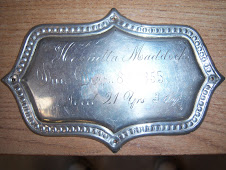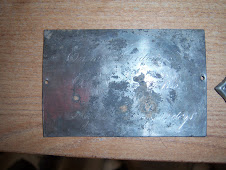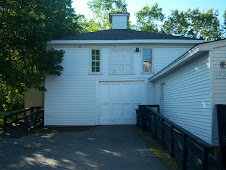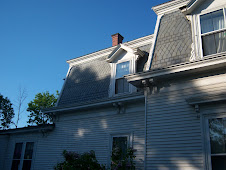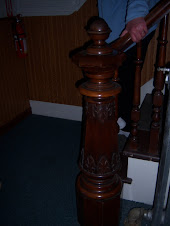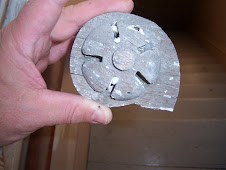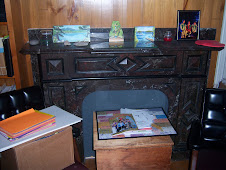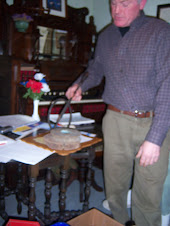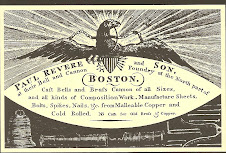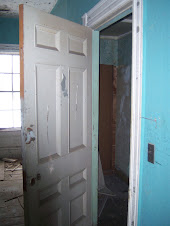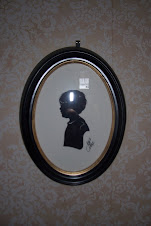This is a press release for a fundraiser at The Curran Homestead Living History Farm and Museum, a non-profit community organization, in Orrington, ME on April 4, 2009. We are now offering reservation times for sittings to the public for silhouette portraits on April 4 from 10AM-2PM at The Curran Homestead. Part of the proceeds will benefit The Curran Homestead. All the information is below, including a short history of the art form that once captured the faces of Mainers and New Englanders in the 19th century and graced the walls of their homes. In addition to the text, I have also included some photos of this artist's work below to go with the article.
If any further information is required, please feel free to contact me at 207-843-5550 or at this email address: rpschmick1@aol.com
In order to get this artist to come up to Orrington, I have to get at least 20 reservations for sittings by March 10. If you think you might be interested contact me. My wife and I will be getting portraits done again of our children by this artist. The two photos are of some portraits we had done in 2007. The Brewer Historical Society might sponsor such a fundraiser in the future, or find another art form from the past that would appeal to the public.
I recently included information about daguerreotypes and an idea for a public demonstration for the BHS. That demonstration might also include public sittings for daguerreotype portraits; I would be the first in line. Tell me what you think. If there are enough people among the membership interested I will seek out the qualified daguerreotypist and go from there with the planning of a fundraiser for BHS. The daguerreotypes don't go with the time frame of The Curran Homestead, so there is no conflict of interest. I am always cognizant of this issue.
Press Release
With few affordable heirloom quality gifts out there, The Curran Homestead Living History Farm and Museum is now taking reservations for appointments for sittings for handmade silhouette portraits by Jean Comerford of Portraits in Silhouette of Hardwick, MA on Saturday, April 4, 2009, 10AM - 2PM at the farm located at 32 Fields Pond Road in Orrington. Our 13th Annual Maple Festival & Irish Celebration will also be underway at the farm from 10AM-2PM with activities, food, stories, music, and more for both kids and adults. Admission to this event for members & donors will be $5 per adult and $3 per child (under 12) and for non-members $7 per adult and $5 per child (under 12). The cost of a silhouette portrait is $29 and $10 for copies. For an additional fee framing is available onsite. Members & donors will receive a 10% discount on their silhouette portraits. Part of the proceeds will benefit The Curran Homestead. For additional information and/or reservations for your portrait sitting on April 4, 2009, 10AM-2PM contact: Robert Schmick at 207-843-5550, or email: rpschmick1@aol.com .
This mother daughter portrait business features a portrait of a famous New Englander in Yankee magazine each month. They are among a handful of artists nationwide who continue this folk art tradition popular in the US and Europe from the late 18th until the mid-19th century. According to Dr. Robert Schmick, volunteer director of educational programs at The Curran Homestead, the silhouette portraits done by Ms. Comerford involve a set of very sharp and precise cutting scissors which she uses to snip out a profile of her subject from black paper which is then mounted on white card. What seems most amazing to watch is that through her skill she achieves a likeness in a matter of minutes.
Schmick added that silhouette portraits were available largely by itinerants as late as the 1870s, but they were most popular during the earlier antebellum era before photography became widespread. Framed family silhouettes would have been among the furnishings of rural Mainers throughout the 19th century. The State Museum in Augusta has had a large collection of silhouettes of antebellum Mainers on display.
Benjamin Franklin referred to the folk art form as “shade” in a letter to his wife, and this, along with “profile,” were common identifications among others in the late 18th century on both sides of the Atlantic. The art form’s current name comes from Etienne de Silhouette, a general controller for the French government, who had the distinction of being both economic to a fault and passing much time snipping out profiles from paper. The popular and inexpensive shadow portraits were known in England by the name “silhouette” by the 1820s as evidenced by the advertisements of Auguste Edouart. Although single portraits with white backgrounds were the norm, this artist was among those who created elaborate backgrounds with ink washes especially for compositions that included multiple familial portraits like one dating from 1842 at the Winterthur Museum in Delaware.
Silhouettes were both cut and painted, and there were a number of ingenious methods employed from the start to achieve the desired profile likeness. Some required far less skill than others. “Shadowgraph” was yet another given name for the “likeness in bust” that characterized most examples, and this was derived from a mechanical device that cut out a profile in the middle of a sheet of paper. The hollowed out sheet was then adhered to a black or colored sheet that accentuated the profile. There were also full length portraits of individuals available too, and some of these are almost comical in their exaggeration of individual characteristics. The early American artist Charles Willson Peale is known to have offered silhouettes portraits at one of his museum in Philadelphia, one of America’s first.
Portraits in America were largely realized by itinerant artists throughout the 18th and 19th centuries, excluding the few who found early patronage and fame. These itinerants were known to practice a variety of skills to make a living from their town to town and sometimes farmhouse to farmhouse travels. Broadsides and the local papers would advertise the availability of their skills for hire, and exhibitions of their silhouettes were not uncommon at the local inn. With the “sheet method,” a life size shadow produced by candle light, would be traced and then reduced to a preferred size through the use of a contraption called a “pantograph.” Miniature profiles could be produced for lockets or to adorn snuffbox lids. The price of a silhouette, as advertised by William King of Salem, MA in 1804, was “twenty five cents for two likenesses of one person.” King claimed to have traversed New England plying his skills in Boston, New Hampshire, and as far north as Portland. Within a two year period, he advertised that he had made some “twenty thousand profiles,” and if that wasn’t enough of a boast he further claimed to do a likeness in “six minutes.”
Such boasting and showmanship was not uncommon for these “hollow cutters,” as they were often called, incorporating as much flourish and theatrics as they could while doing portraits often before a crowd. This propensity was no better exemplified than by the “Master Sanders K.G. Nellis,” a paraplegic, who with “scissors in toes cut valentines and watch papers very ingeniously, and will also cut the likeness of persons very correctly.” He would also shoot bow and arrow, play the cello, and write with the only limbs he was born with according to an 1836 Salem newspaper advertisement.
Robert Schmick, Ph.D., Director of Education, The Curran Homestead, PO Box 107, Orrington, ME 04474-0107, Tel. (207) 843-5550, Email:rpschmick1@aol.com, website: http://curranhomestead.org
Friday, February 27, 2009
Wednesday, February 25, 2009
Quote
"Even today, in societies of almost universal literacy , it is a rare soul who bequeaths to future historians a written account of his thoughts...How can you study a society if you attend only to the expressions of a small and deviant class within the whole?" (Schlereth 142)
References
Schlereth, Thomas J. ed. Material Culture Studies in America. Walnut Creek, CA: Altamira Press, 1999.
References
Schlereth, Thomas J. ed. Material Culture Studies in America. Walnut Creek, CA: Altamira Press, 1999.
Definitions
material culture consists of "artifacts (and other pertinent historical eveidence) of the belief systems---values, ideas, attitudes, and assumptions---of a particular community or society, usually across time" (Schereth 3). It can include "landscapes, tools, Buildings, housegood goods, clothing, and art;" it is the communication of specific human messages through objects (McDannell 2).
References
McDannell, Colleen. Material Christianity; Religion and Popular Culture in America. New Haven and London: Yale University Press, 1995.
Schlereth, Thomas J. ed. Material Culture Studies in America. Walnut Creek, CA: Altamira Press, 1999.
References
McDannell, Colleen. Material Christianity; Religion and Popular Culture in America. New Haven and London: Yale University Press, 1995.
Schlereth, Thomas J. ed. Material Culture Studies in America. Walnut Creek, CA: Altamira Press, 1999.
Tuesday, February 24, 2009
Daguerreotypes: What are they, How do we care for them, and How do we store and exhibit them for optimal preservation?
Recently, I was given a tour by Phyllis Scribner of the Brewer Historical Society collections at The Clewley House Museum on Wilson Street. It was a real treat. I noticed that there are a number of daguerreotypes in the collection. I did a lot of research on this early and unique form of photography for a term paper for my Collections Care and Preservation class at Tufts last year. I have hightlighted some of this research in the following fact sheet, which I had promised to get to Phyllis Scribner and David Hanna.
Beyond all the information below, everyone should keep in mind that the daguerreotype is probably the most perfect and precise form of photography, and it, in many ways, surpasses any other form of photography to date. A perfectly executed daguerreotype portrait can, under magnification, reveal even individual pores of its subject. This is a far cry from the high resolution pixelation found with digital photography that never achieves as precise a record of its subject.
For those interested, I have a wonderful hardcover catalog ( my wife Jean gave it to me as a birthday present, and I know it cost a small fortune because I researched the price before I started dropping hints---used copies can be had on amazon.com) from the Museum of Fine Art's recent daguerreotype exhibition (a rare showing of this type of photography) of a very famous antebellum Boston photography firm. The exhibition was entitled: Young America: The Daguerreotypes of Southworth and Hawes. These photos date from the 1840s and 50s, and there are some shots of US Presidents and personalities from that time period that are rather disturbing because of the degree of detail captured in them---HD (high definition) TV has nothing on these. In addition, I have this wonderful volume of the complete Civil War plates of Matthew Brady, who had switched to the wet-collodion process by the 1860s which allows for printing on paper rather than copper-plate; hence, many copies could be reproduced from the original. These are quite spectacular too. This was unlike daguerreotypes which were unique images allowing for no negative for reproduction; the only way it could be reproduced was to photograph the plate itself.
Let me know if you are interested, and I will lug these babies to the March 3 meeting for perusal. Since we have a small collection of daguerreotypes, it would be interesting to have a modern-day daguerreotypist come to a meeting and demonstrate the process. We could sell admission tickets; I would buy one. I have never seen it done live. I think that the public would be interested in seeing this done as well. No dark room required. For those in the know, there are alternatives to the heated mercury originally used; we don't want to create any mutants, if we were to have a public demonstration.
Daguerreotype Fact Sheet
Identification
Beyond all the information below, everyone should keep in mind that the daguerreotype is probably the most perfect and precise form of photography, and it, in many ways, surpasses any other form of photography to date. A perfectly executed daguerreotype portrait can, under magnification, reveal even individual pores of its subject. This is a far cry from the high resolution pixelation found with digital photography that never achieves as precise a record of its subject.
For those interested, I have a wonderful hardcover catalog ( my wife Jean gave it to me as a birthday present, and I know it cost a small fortune because I researched the price before I started dropping hints---used copies can be had on amazon.com) from the Museum of Fine Art's recent daguerreotype exhibition (a rare showing of this type of photography) of a very famous antebellum Boston photography firm. The exhibition was entitled: Young America: The Daguerreotypes of Southworth and Hawes. These photos date from the 1840s and 50s, and there are some shots of US Presidents and personalities from that time period that are rather disturbing because of the degree of detail captured in them---HD (high definition) TV has nothing on these. In addition, I have this wonderful volume of the complete Civil War plates of Matthew Brady, who had switched to the wet-collodion process by the 1860s which allows for printing on paper rather than copper-plate; hence, many copies could be reproduced from the original. These are quite spectacular too. This was unlike daguerreotypes which were unique images allowing for no negative for reproduction; the only way it could be reproduced was to photograph the plate itself.
Let me know if you are interested, and I will lug these babies to the March 3 meeting for perusal. Since we have a small collection of daguerreotypes, it would be interesting to have a modern-day daguerreotypist come to a meeting and demonstrate the process. We could sell admission tickets; I would buy one. I have never seen it done live. I think that the public would be interested in seeing this done as well. No dark room required. For those in the know, there are alternatives to the heated mercury originally used; we don't want to create any mutants, if we were to have a public demonstration.
Daguerreotype Fact Sheet
Identification
- Images on silver plated copper produced between 1839-1865.
- A mirror-like surface with a bluish tint. If you hold it in a particular way, the image seems to disappear.
- To identify one, hold a light colored piece of paper with writing on it at right angles in front of it. The letters will reflect on the surface in reverse, and individual letters will appear as negative images.
- They look like ambrotypes, but ambrotypes are glass plates that reflect a reverse image as a positive.
- They are usually housed in double paneled cases that consist of two wooden frames encased in leather, papier mache, some early plastic-resin material, or other material.
One side of the case usually holds a cushion and the other an image behind glass. - The daguerreotype case served as both a decorative object and an airtight micro-environment for a photographic image bound to a silver-plate surface through a chemical process of mercury amalgamation.
Deterioration (Agents of Deterioration)
- Physical damage includes broken glass and damage to the exterior of the protective case.
- Case damage includes complete loss, leather dry rot, cracks, and brittleness.
- A compromised micro-environment causes oxidation. The silver plating is transformed by contact with airborne sulphur in various degrees at the contact point between the image and its framing.
- Fixer crystals from unfiltered solutions in the original processing cause black spots on the surface of the plate.
- Copper crystals in the form of green specks are caused by deficiencies in the original silver plating or through scratches or punctures to the plate’s surface. Exposing copper to oxygen and moisture turns it green.
- Heat and moisture are daguerreotype's greatest enemies, not light. Extreme heat may breakdown the chemical process that made these photographs possible.
- Extreme cold will effect the surface too; unheated storage in cold climates allows for condensation.
- Moisture may cause mold on the surface of the plate. This mold scars an image permanently.
- Scratches on the image’s surface were likely caused by the shifting of the micro-environment’s components, or through fixing a plate face-down in a tray of fixer. This deterioration has been assisted by a human agent.
- Beware of plastic reproduction cases for the replacement of unsalvageable cases for vintage daguerreotypes because the combination of materials can case a static electricity charge that can lift tinted emulsions from the daguerreotype’s surface.
- Pests, who usually target books (booklice, powder post beetles, and the like) are attracted to the leather, wood, and paper materials that make up the daguerreotype’s case.
Preservation and Restoration
- Preservation and restoration should always be carried out by a trained photograph conservator.
- A new and efficient micro-environment can be created by replacing some materials of the daguerreotype case to insure that further oxidation does not occur.
Storage and Display
- Ideal storage and display conditions: 68 degrees Fahrenheit (20 degrees Celsius) and 40-50% relative humidity. Remember that 70 degrees Fahrenheit and 70 % relative humidity is an ideal condition for mold, bugs, and other pests. Avoid it.
- The first defense of the daguerreotype is its case. The case should be preserved through limited handling. A four flap envelope made of archival corrugated board is an ideal second defense. A third and final exterior defense can be a custom made archival box of archival board that allows both the case and its four flap envelop to slide into it securely.
- A scan of the daguerreotype might be attached in a Mylar envelope on the outside of the archival box along with the accession number. An accession number may also be attached to the photo itself by an acid-free string holding its label. Museums often prefer not to write an accession number on the plate or case itself.
- The archival box, containing the daguerreotype, should be stored in metal cabinetry with a baked powder enamel coating. When this is unavailable, cabinetry of other materials, like painted metal, may be a better choice than cabinetry made of composites of woods prone to off-gassing and other deterioration issues. Archival boxes, with daguerreotypes within, should be placed side-by-side rather than stacked one on top of each other.
- Stacking causes weight to compress plastic-resin and leather cases changing their form over time; it should be avoided. It may also put pressure on fragile glass breaking it, which would cause oxidation to the plate.
- Museums often choose scans of daguerreotypes mounted on fome-cor for long term displays. They keep the original secure in storage.
- It is not light that deteriorates daguerreotypes but heat and moisture. The rule of no more than 5 foot candles or 50 lumens for all photographs should nevertheless be observed.
Housekeeping
- Keep areas of storage and exhibition free of dust and debris.
- Maintain the recommended temperature and relative humidity for these photographs. Ideally, modern HVAC systems are a preventive against undesired temperatures and relative humidity as well as mold and pests caused by them.
- Consult a pest control specialist about insects and vermin. Be aware that some pesticides contain oils that may stain objects they come in contact with. Avoid them, if possible.
Disaster
- Good storage practices are the first and best line of defense against disaster.
- Separating photographs from a storage area after disasters like fire and flood is prudent.
- A trained photography conservator should be consulted specifically about preservation and conservation of daguerreotypes in such a circumstance.
Monday, February 23, 2009
Chamberlain Freedom Park
On a replica of Gettysburg’s Little Round Top at the corner of State and North Main streets in Brewer, stands a bronze statue of Col. Joshua Chamberlain, who commanded the 20th Maine volunteers and on July 2, 1863 successfully defended the flank of the Union army from an intense confederate barrage. Sculptors Glenn and Diane Hines of Houlton created a conception of the man who may have very well preserved the union. Out of ammunition and surrounded by the dead and dying, Chamberlain had one option. He called for the 20th Maine to fix bayonets and in an incredible display of daring and courage, charged the advancing confederate brigade and so confused the rebels that they surrendered. The day was saved and the next day, the confederate attempt to break the middle of the union army failed. That was the turning point of the Civil War. Chamberlain Freedom Park was made possible by Brian Higgins, past president of the Brewer Historical Society and Representative Dick Campbell who on Veterans day in 1997 saw their labors come to fruition. When the Maine DOT razed the home of abolitionist John Holyoke for the new bridge, Higgins and Campbell started a national campaign to raise funds. A plaque recognizes their contribution in the design and historical designation of the site. In 2002, the Hines’ created another bronze of an escaped slave climbing out of a tunnel believed to be part of the “underground railroad”, an escape route from the south to Canada. The statue called “North to Freedom” is meant as a tribute to those who traveled to freedom and to those who risked their lives to help them. The Brewer Historical Society is entrusted to maintain the park and receive income from a series of advertising signs at the base of the hill. To all those who created and maintain this tribute to freedom, we are deeply grateful.
Wednesday, February 18, 2009
Maine State Archives Grants; Let's Apply!
I would like to talk with fellow members of the Brewer Historical Society about ideas for our own application for the following grants ( See the press release below) from the Maine State Archives for a May 1 or December 15 deadline. I am offering my services, and I am open to suggestions. There is no conflict of interest because I have been informed that grants are usually not given to the same institutions repeatedly. I am a volunteer. Bob Schmick, email: kitapsevenkimse@aol.com
FOR IMMEDIATE RELEASE
The Curran Homestead Living History Farm and Museum Receives Two Grants from the Maine State Archives
AUGUSTA-The Curran Homestead Living History Farm and Museum has received $1,738.96 for a Historical Museum Collections Grant and $2,651.44 for a Historical Facilities Grant to improve both the documentation associated with their collection of material culture and to improve facilities housing for their historical collections. The grants were provided by the Maine State Museum with funds from the State of Maine’s New Century Community Program.
One of the projects will include creating archives of oral histories by Dr. Robert Schmick, a volunteer director of The Curran Homestead, that links specific tools for blacksmithing in their collection with their use by a professional blacksmith still practicing traditional techniques. In this series of digital recordings, the uses of each blacksmithing tool in the collection will be addressed as well as step-by-step directions on how to complete a number of forge projects.
Master Blacksmith Robert Robinson of Split Rock Forge in Stockton Springs, ME will additionally share his knowledge of local blacksmithing practices of the past and give instructions on the firing and maintenance of the forge during the metal fabrication process. These recordings will eventually be made available as podcasts on the Internet. The equipment for recording, processing, and storage of these oral histories provided by this grant will further assist in the completion of a series of recordings on a variety of themes including the material culture of rural life and family farming in Maine and specific farm and commercial tasks particular to our region’s past like ice harvesting and the making of maple syrup, among others.
The second grant will provide the funds for the materials to build a wooden blacksmithing shed on the farm and museum site. This structure will be entirely constructed by our volunteer staff. It will house our collection of tools and accoutrements for blacksmithing that includes a portable forge with a built-in bellows. It will provide a space for blacksmithing instruction, forge projects, and storage of student work in the future.
“These grants support community efforts to preserve and share the stories of our people, our towns, our families and how we lived our lives,” noted Joseph R. Phillips, Museum Director of the Maine State Museum. “Without these objects and buildings, important pieces of our Maine heritage would be lost.” Secretary of State Matthew Dunlap says a recent report to the Maine Legislature indicated many of Maine’s historical collections (photographs, paintings, natural history collections, letters, etc.) are in danger of being lost to mold, fire, theft, or misuse. “Maine has an estimated 200 million historical objects and records, many in facilities with little or no security, fire protection, or environmental controls. Maine people in local government, historical societies, and libraries are seeking help to preserve heritage,” Secretary Dunlap commented. Small grants have stimulated local citizens and organizations to commit more of their own resources to these projects. “Although financial support is important, recognition of local concerns and effort through an award should also generate a substantial amount of enthusiasm,” Phillips noted.
For more information about the Historical Facilities and Historical Museums Collections Grant Program, call the Cultural Resources Information Center at 287-7591 or email: maine.cric@maine.gov .
FOR IMMEDIATE RELEASE
The Curran Homestead Living History Farm and Museum Receives Two Grants from the Maine State Archives
AUGUSTA-The Curran Homestead Living History Farm and Museum has received $1,738.96 for a Historical Museum Collections Grant and $2,651.44 for a Historical Facilities Grant to improve both the documentation associated with their collection of material culture and to improve facilities housing for their historical collections. The grants were provided by the Maine State Museum with funds from the State of Maine’s New Century Community Program.
One of the projects will include creating archives of oral histories by Dr. Robert Schmick, a volunteer director of The Curran Homestead, that links specific tools for blacksmithing in their collection with their use by a professional blacksmith still practicing traditional techniques. In this series of digital recordings, the uses of each blacksmithing tool in the collection will be addressed as well as step-by-step directions on how to complete a number of forge projects.
Master Blacksmith Robert Robinson of Split Rock Forge in Stockton Springs, ME will additionally share his knowledge of local blacksmithing practices of the past and give instructions on the firing and maintenance of the forge during the metal fabrication process. These recordings will eventually be made available as podcasts on the Internet. The equipment for recording, processing, and storage of these oral histories provided by this grant will further assist in the completion of a series of recordings on a variety of themes including the material culture of rural life and family farming in Maine and specific farm and commercial tasks particular to our region’s past like ice harvesting and the making of maple syrup, among others.
The second grant will provide the funds for the materials to build a wooden blacksmithing shed on the farm and museum site. This structure will be entirely constructed by our volunteer staff. It will house our collection of tools and accoutrements for blacksmithing that includes a portable forge with a built-in bellows. It will provide a space for blacksmithing instruction, forge projects, and storage of student work in the future.
“These grants support community efforts to preserve and share the stories of our people, our towns, our families and how we lived our lives,” noted Joseph R. Phillips, Museum Director of the Maine State Museum. “Without these objects and buildings, important pieces of our Maine heritage would be lost.” Secretary of State Matthew Dunlap says a recent report to the Maine Legislature indicated many of Maine’s historical collections (photographs, paintings, natural history collections, letters, etc.) are in danger of being lost to mold, fire, theft, or misuse. “Maine has an estimated 200 million historical objects and records, many in facilities with little or no security, fire protection, or environmental controls. Maine people in local government, historical societies, and libraries are seeking help to preserve heritage,” Secretary Dunlap commented. Small grants have stimulated local citizens and organizations to commit more of their own resources to these projects. “Although financial support is important, recognition of local concerns and effort through an award should also generate a substantial amount of enthusiasm,” Phillips noted.
For more information about the Historical Facilities and Historical Museums Collections Grant Program, call the Cultural Resources Information Center at 287-7591 or email: maine.cric@maine.gov .
Wednesday, February 11, 2009
Press Release: Ice Harvesting on Fields Pond on Sunday, February 15, 2009, 2-4 PM.
All Brewer Historical Society members are welcome to come to The Curran Homestead Living History Farm and Museum's first annual ice-harvesting re-enactment on Fields Pond in Orrington this Sunday, February 15, 2009. I have been crossing my fingers that there isn't too much melting before that date arrives. The ice was about 24 inches thick a lttle more than a week ago when I checked with some fisherman out on the pond, but we've had some relatively warm days since then...
Press Release:
“On Sunday, February 15, from 2 to 4 PM, we’ll go out on Fields Pond in Orrington and harvest a block of ice” according to Dr. Robert Schmick, The Curran Homestead’s Volunteer Director of Education Programs. “This will be a first for the Curran Homestead Living History Farm and Museum, so it is intended to be informal and experimental rather than a formal historical re-enactment. Using authentic ice harvesting tools from our collection, and substitutions for those we don't presently have (and seek for future annual harvesting), we will cut a block of ice from Fields Pond and transport it up the hill to the kitchen of the Curran House where it will be placed in our vintage oak and zinc-lined ice box for the first time in many decades,” Schmick added.
The Curran family once harvested ice from Fields Pond in Orrington, ME. Many Maine farmers similarly utilized what ice they had on their property for personal and commercial purposes. At the beginning of the 19th century, ice harvesting was the seventh largest industry in the US with New England exporting their renowned clear ice blocks to such exotic destinations as the Caribbean and India.
Schmick added “this is foremost a learning experience for us and for those who join us. We welcome those people who have first-hand experiences with, or information about, ice-harvesting, and we’d look forward to any sharing of experience. We’ll have a warming center in our Sugar Shack at the farm where hot cocoa will be available. There is no admission charge, but donations are always welcomed.”
As background, Schmick said, “The Currans were among the sturdiest of a strong breed of farmers who settled on the rocky New England hillsides during the 19th Century. They gave thrift, frugality and industry a new meaning even among a people known for those values.”
John Mugnai, The Curran Homestead Board President, stated “the goal of our project is to demonstrate for future generations the virtues of self-reliance, cooperation, industry and thrift which reflect the traditional American values practiced when our society was predominantly rural. By showing the earlier technology, we can demonstrate for young minds, and recall to older minds, how rural America lived off the land.”
“The mission of The Curran Homestead is to enrich the lives of our children, offer our community many opportunities for wholesome family fun, and serve as an excellent educational resource through museum displays and hands-on activities and programs” added Mugnai.
For more information contact:
Robert Schmick (207) 843-5550
Email: kitapsevenkimse@aol.com
Press Release:
“On Sunday, February 15, from 2 to 4 PM, we’ll go out on Fields Pond in Orrington and harvest a block of ice” according to Dr. Robert Schmick, The Curran Homestead’s Volunteer Director of Education Programs. “This will be a first for the Curran Homestead Living History Farm and Museum, so it is intended to be informal and experimental rather than a formal historical re-enactment. Using authentic ice harvesting tools from our collection, and substitutions for those we don't presently have (and seek for future annual harvesting), we will cut a block of ice from Fields Pond and transport it up the hill to the kitchen of the Curran House where it will be placed in our vintage oak and zinc-lined ice box for the first time in many decades,” Schmick added.
The Curran family once harvested ice from Fields Pond in Orrington, ME. Many Maine farmers similarly utilized what ice they had on their property for personal and commercial purposes. At the beginning of the 19th century, ice harvesting was the seventh largest industry in the US with New England exporting their renowned clear ice blocks to such exotic destinations as the Caribbean and India.
Schmick added “this is foremost a learning experience for us and for those who join us. We welcome those people who have first-hand experiences with, or information about, ice-harvesting, and we’d look forward to any sharing of experience. We’ll have a warming center in our Sugar Shack at the farm where hot cocoa will be available. There is no admission charge, but donations are always welcomed.”
As background, Schmick said, “The Currans were among the sturdiest of a strong breed of farmers who settled on the rocky New England hillsides during the 19th Century. They gave thrift, frugality and industry a new meaning even among a people known for those values.”
John Mugnai, The Curran Homestead Board President, stated “the goal of our project is to demonstrate for future generations the virtues of self-reliance, cooperation, industry and thrift which reflect the traditional American values practiced when our society was predominantly rural. By showing the earlier technology, we can demonstrate for young minds, and recall to older minds, how rural America lived off the land.”
“The mission of The Curran Homestead is to enrich the lives of our children, offer our community many opportunities for wholesome family fun, and serve as an excellent educational resource through museum displays and hands-on activities and programs” added Mugnai.
For more information contact:
Robert Schmick (207) 843-5550
Email: kitapsevenkimse@aol.com
Tuesday, February 10, 2009
Oral History Project
Dr. Robert Schmick addressed the January 13th meeting of the Brewer Historical Society at the Brewer Auditorium. Dr. Schmick is the Director of Education at the Curran Homestead Living History Farm and Museum. Presently he is obtaining oral histories of individuals in the area and will incorporate taped interviews and pictures into internet accessible programs. That means that an important link to the past will be made available to everyone. Students and members of the community can use present day technology to obtain information from those who have personal recollections of Brewer during the twentieth century and before. I would hope that each member of the historical society as well as Brewer citizens would reflect on the legacy that could be left to the community by contacting Dr. Schmick to discuss the possibility of being recorded for posterity. I am sure that many people have reflections of Brewers past, be it of one of the industries such as lumbering, ice harvesting, brick making, ship building, Eastern Manufacturing, milling, or a myriad of other businesses. In addition you have recollection of events and stories that could be passed down to future generations. I encourage you to contact Dr. Schmick at rpschmick1@aol.com
Subscribe to:
Comments (Atom)

